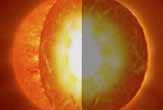
A NASA spacecraft designed to seek out alien worlds has also revealed new details about the structure and evolution of stars, and should help astronomers better understand the future of our own sun, researchers announced today (Oct. 26).
Researchers measured so-called "starquakes," observing oscillations in the brightness of thousands of stars in much the same way geologists study earthquakes to probe our planet's interior. NASA's planet-hunting Kepler spacecraft served as their tool.
The method, called asteroseismology, is helping astronomers characterize stars as never before, researchers said during a news conference at Aarhus University in Denmark.
"We are just about to enter a new area in stellar astrophysics," Thomas Kallinger, of the University of British Columbia and the University of Vienna, said in a statement. "Kepler provides us with data of such good quality that they will change our view of how stars work in detail."
Kepler: A multipurpose instrument
NASA launched the Kepler spacecraft in March 2009 with a primary mission of finding Earth-like alien planets.
So far, it has identified at least 700 "candidate stars" that could harbor alien worlds. But researchers are also using the spacecraft to analyze the stars such planets may be circling.
Sign up for the Live Science daily newsletter now
Get the world’s most fascinating discoveries delivered straight to your inbox.
"Our knowledge of the planets Kepler discovers is only as good as our knowledge of the stars that they orbit," said Kepler mission co-investigator Natalie Batalha, of San Jose State, during the news conference.
As an example of what asteroseismology can reveal, the researchers offered up a star called KIC 11026764.
By studying its pulses, astronomers have learned more about this star than they know about virtually any star in the universe aside from our sun.
Researchers determined, for example, that KIC 11026764 is 5.94 billion years old and is roughly twice the size of our sun. KIC 11026764 will continue to grow, eventually transforming into a red giant, researchers said.
Such information, once gathered for hundreds or thousands of stars, will help astronomers understand stellar structure and evolution in a general sense. And it could help scientists evaluate the chances that alien planets could harbor life, researchers said.
Kepler detects alien planets by watching for the telltale dimming in a star's brightness caused when a planet crosses in front of it from Kepler's vantage point. The amount of dimming reveals how big the planet is relative to its star — but not its actual size.
So knowing the size of the star will tell researchers how big its planets are, if it has any, researchers said. Knowing a star's age and what stage it is at in its stellar evolution can also help astronomers judge how likely it is for any alien planets around it to harbor life.
No planets are known to orbit KIC 11026764, but asteroseismology could theoretically be applied to stars that host planets, researchers said.
Red giants and stellar lighthouses, too
Astronomers have been using Kepler to characterize the structure and life cycle of 1,000 red giants. Later in its life, the sun will one day become one of these huge, bloated stars.
Researchers also reported on the star RR Lyrae. It has been studied for more than 100 years as the first member of an important class of stars used to measure cosmological distances. The brightness of the star oscillates within a well-known period of about 13.5 hours, researchers said. Yet during that period, other small, cyclic changes in amplitude occur — behavior known as the Blazhko effect.
The effect has puzzled astronomers for decades, but Kepler data may have yielded a clue to its origin, researchers said. Kepler observations revealed an additional oscillation period that had never been previously detected. The oscillation occurs with a time scale twice as long as the 13.5-hour period. The Kepler data indicates the doubling is linked to the Blazhko effect.
"Kepler data ultimately will give us a better understanding of the future of our sun and the evolution of our galaxy as a whole," Daniel Huber, of the University of Sydney, said in a statement.
The Kepler spacecraft uses a huge digital camera, known as a photometer, to continuously monitor the brightness of more than 150,000 stars in its field of view as it orbits the sun. The research team using the telescope to study stars is an international collaboration known as the Kepler Asteroseismic Science Consortium.












